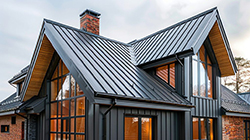
Metal Roofing Misconceptions and Myths
Metal roofing has become a popular choice for homeowners seeking durability, sustainability, and energy efficiency. Despite its growing appeal, there are several myths and misconceptions about metal roofing that can deter homeowners from considering metal roofs for their homes. Let’s address some of these metal roofing myths and set the record straight.
Common Myths for Homeowners
As metal roofing technologies and designs continue to evolve, it’s important to separate misconceptions from facts. Concerns about noise, corrosion, or temperature often cause homeowners to hesitate, but today’s innovative metal roofing options offer unparalleled benefits.
Metal Roof Noise
One of the most persistent metal roofing misconceptions is that the material creates excessive noise during rain, hail, and storms. In reality, noise levels with metal roofs are comparable to traditional asphalt roofs. Modern installation techniques and materials mean that sound is effectively dampened, giving you peace and quiet, even during a downpour. Specifically, the underlayment and insulation of metal is a major reason why noise isn’t an issue.
Metal Will Rust & Corrode
Many homeowners worry that metal roofs will rust or corrode over time, which is based on outdated information. Today’s metal roofs are made with protective coatings that withstand rust and corrosion, including galvanization, galvalume, and other primers. Fabral also provides Lifetime Film and Chalk & Fade warranties for up to 30 years, and a 25-year warranty for perforation on walls. This helps you ensure your home looks beautiful for decades to come.
Metal Roofs Bring Heat In
There’s a common misconception that metal materials will significantly increase the temperature inside of the home, especially during warmer months. However, modern metal roofs are designed with high solar reflectance. This helps to keep your home cooler by reducing surface temperatures, which can also reduce cooling costs compared to traditional asphalt shingles. A well-designed metal roofing system combined with insulation and ventilation can enhance the temperature regulation of the home, lowering the workload of the HVAC system.
Common Myths for Professionals
Professional builders and architects also encounter many misconceptions about metal roofing. By addressing these myths, they can help homeowners make informed decisions and recognize the value of metal roofing.
Weather will Damage Metal Roofs
While no roofing material is completely resistant to extreme weather, modern metal roofing systems offer superior protection compared to other materials. Metal is a much sturdier material than shingles thanks to its unique composition and panel designs.
It is important for professionals to inform homeowners that the sturdiness of metal roofing not only provides great protection but also that metal roofs are built to last and withstand environmental challenges.
Installation Practices are More Difficult for Metal Roofs
There is a belief that metal roofing installation practices are more complex than traditional roofing installations. This perception leads to concerns about increased installation times and higher labor costs. While metal roofing installation does require specific skills and knowledge, it’s not necessarily more difficult.
The installation techniques for attaching metal panels are different than asphalt shingles, but they are generally straightforward. Some panels are seamless and configured to snap together, while other panels may require screws or nails to attach them. Installing metal panels is another technique professionals learn, and Fabral makes it easy with our panels designed for simple installations.
Higher Labor Costs for Metal Roofs
Another misconception is that metal roofing installations are significantly more expensive than traditional options. This misconception stems from the perception that metal roofing is more complex and time-consuming to install. Most of the costs for metal roof work come from materials, supply chain, and equipment. The need for custom elements for most projects also increases cost.
While the upfront labor costs may be higher, long-term benefits including durability, low maintenance, and energy savings often offset these initial costs. Metal typically lasts 2-3 times longer than traditional materials, providing significant savings over the roof’s life.
Long-Term Benefits of Metal Roofing
Investing in metal roofing systems offers long-term benefits. With a lifespan of 40-50 years, they offer durability, sustainability, and low maintenance making metal roofing an excellent investment for homeowners.
Durability, Sustainability, and Low Maintenance
Metal materials resist weathering and corrosion, leading to lower maintenance costs. They are often made from recycled materials, making them 100% recyclable at the end of their lifetime. The energy-efficient properties of metal help reduce carbon footprints over time. This makes metal roofing a smart choice for environmentally conscious homeowners.
Check out our Vision House project to see how innovative metal roofing solutions can enhance both performance and design, all while providing durability and aesthetic appeal in equal measure.
Metal Roofing Technologies
Metal roofing technologies address concerns like insulation and ventilation. For example, the design components of perforated panels allow for ventilation. Soffit panels cover the underside of the metal roof, protecting the home from weather elements and allowing for ventilation between the attic and roof. The airflow of these panels is great for airflow and drainage.
Versatility of Metal Roof Design
Contrary to the belief that metal roofing is only for industrial or modern designs, metal roofing materials are incredibly versatile. With options like shadow lines and exposed or concealed panels, metal roofs can complement any architectural style.
Fabral offers 22 colors for their metal roof and wall panel line. These coatings resist chalking, fading, and scratching and provide superior weatherability and outstanding color consistency. They’re available on a range of Fabral’s residential and agricultural panels, including the Grandrib Series, the Horizon Series, and trim and soffit panels.
Industry Trends & Innovations Changing the Perception of Metal Roofing
The perception of metal roofing has significantly evolved, driven by innovations in materials, design, and sustainability that have reshaped its image. Metal roofing is known as a premium option for both residential and commercial properties.
Some innovations include: